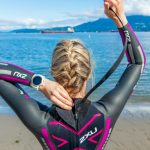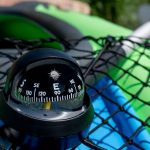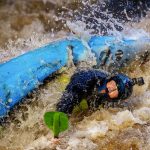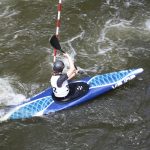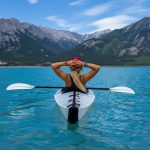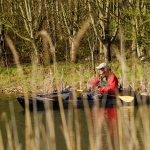Inflatable life jackets aren’t common in kayaking but can be a great choice. We'll look at some top-rated inflatable PFDs to see which one is right for you.
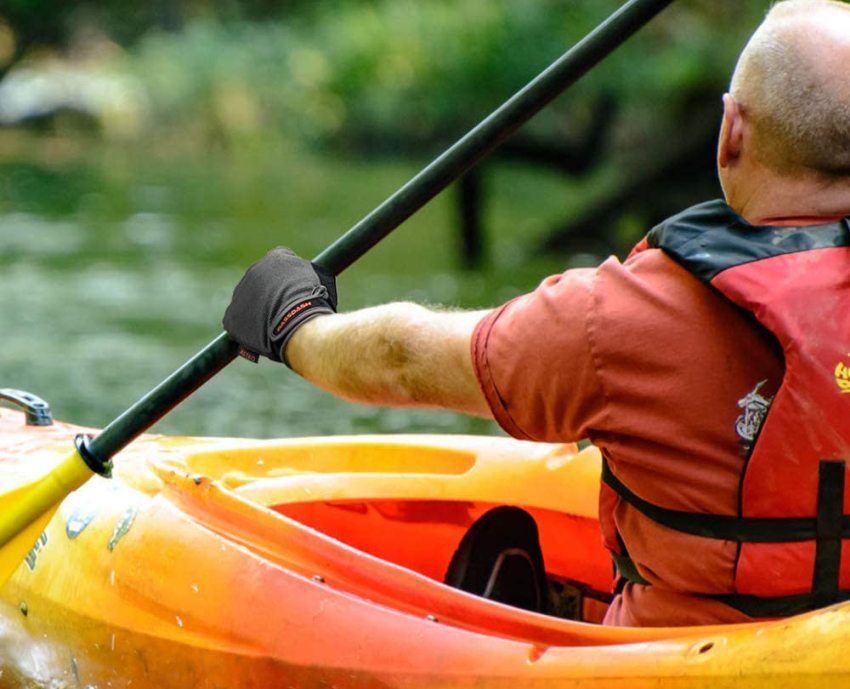
Kayaking gloves can be an absolute game-changer!
During the summer, they protect your hands from excessive sunlight exposure (and, of course sunburn).
During the cooler and colder months, they keep your hands toasty warm even in frigid water.
And no matter when you use them, they’re the perfect solution for preventing calluses and protecting your hands from the usual friction of gripping/wielding your paddle.
Trust me, after a day-long or multi-day paddling trip, that skin between your thumb and forefinger gets rubbed absolutely raw. Unless you’ve got tough-as-leather skin (which I definitely don’t!), you’re going to want a pair of gloves to protect your hands.
Below, you’ll find a complete list of all the best kayaking gloves available today—not just for summer use, but also for cold-weather kayaking.
We’ve also compiled a complete buying guide with all the information you need to know about shopping for the best pair of gloves to take kayaking—breaking down form, function, and everything in between.
By the end of this page, you’ll know exactly what pair of kayaking gloves will suit your activity level and paddling habits best.
As an affiliate of Amazon and other retailers, we may earn a small commission when you buy via our links, at no additional cost to you. Thank you!
Quick Answer: The Best Kayaking Gloves for You
Don’t have time to read the whole article? No problem! Check out our condensed list to find the best kayaking gloves for your needs:
- The Fishing Tree Fingerless Fishing Gloves
- KastKing Sol Armis Sun Gloves
- Glacier Glove Islamorada Fingerless Sun Gloves
- NeoSport 3/4 Finger Neoprene Gloves, 1.5mm
- NRS Hydroskin Gloves
- Hyperflex 3/4 Fingerless Gloves
- BASSDASH Astro Heavy-Duty Gloves
- BPS Water Gloves
- Seavenger Abyss 1.5mm Neoprene Diving Gloves
- Neo Sport Premium Neoprene Wetsuit Gloves
- Glacier Glove Perfect Curve Waterproof Fleece-Lined Neoprene Gloves
- HEYTUR Neoprene Pogies
Comparison Table: Best Kayaking Gloves
| Model | Specs | Where to Buy |
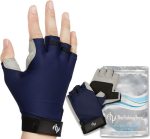 The Fishing Tree Fingerless Fishing Gloves | Material: Spandex, synthetic leather Style: Fingerless UPF rating: UPF/SPF 50 | Amazon |
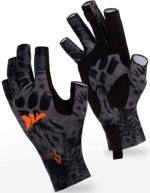 KastKing Sol Armis Sun Gloves | Material: Polyester and spandex Style: Fingerless UPF rating: UPF/SPF 50 | Amazon |
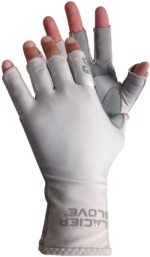 Glacier Glove Islamorada Fingerless Sun Gloves | Material: Lycra and synthetic leather Style: Fingerless UPF rating: UPF50+ | Amazon |
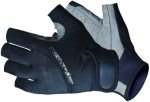 NeoSport 3/4 Finger Neoprene Gloves, 1.5mm | Material: Neoprene and synthetic leather Style: Fingerless UPF rating: Unspecified | Amazon |
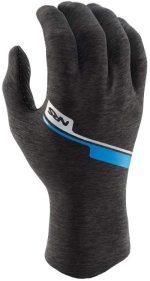 NRS Hydroskin Gloves | Material: PowerSpan synthetic fabric Style: Full finger UPF rating: Not rated | Amazon |
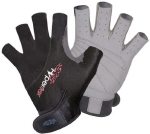 Hyperflex 3/4 Fingerless Gloves | Material: Spandex and synthetic leather Style: Fingerless UPF rating: Unspecified | Amazon |
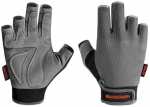 BASSDASH Astro Heavy-Duty Gloves | Material: Neoprene, Spandex, and synthetic leather Style: Fingerless UPF rating: Unspecified | Amazon |
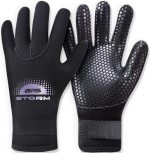 BPS Water Gloves | Material: Neoprene Style: Full finger UPF rating: Unrated | Amazon |
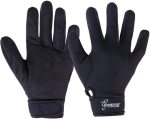 Seavenger Abyss 1.5mm Neoprene Diving Gloves | Material: Neoprene and synthetic leather Style: Full-finger UPF rating: Unrated | Amazon |
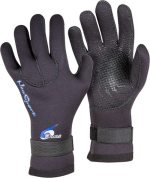 Neo Sport Premium Neoprene Wetsuit Gloves | Material: Neoprene Style: Full finger UPF rating: Unrated | Amazon |
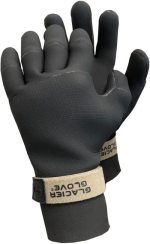 Glacier Glove Perfect Curve Waterproof Fleece-Lined Neoprene Gloves | Material: Neoprene exterior with fleece lining Style: Full finger UPF rating: Unspecified | Amazon |
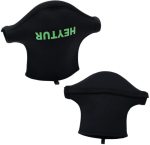 HEYTUR Neoprene Pogies | Material: Neoprene Style: Pogie UPF rating: Unrated | Amazon |
Top-Rated Kayaking Gloves
The Fishing Tree Fingerless Fishing Gloves
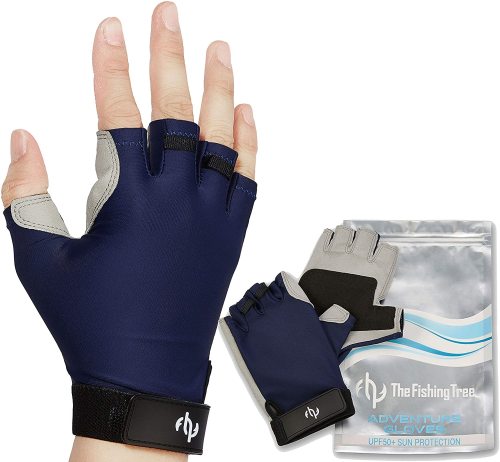
Material: Spandex, synthetic leather
Style: Fingerless
UPF rating: UPF/SPF 50
If you’re looking for lightweight kayaking and fishing gloves, you’ll love these bad boys! Made from a mixture of elastic Spandex and a tough synthetic leather, they’re hardy enough to endure two or three paddling seasons without breaking.
The Spandex is breathable, quick-drying, and moisture-wicking, so your hands will stay cool and dry all day long. They’ve got just enough elasticity that you can easily slide your hands in and out, but the gloves have a nice snug fit. Best of all, they’re machine-washable with a hook-and-loop Velcro closure that will keep them securely on your hands at all times.
Pros:
- Lightweight yet surprisingly durable
- Comfortable; great for fishing and paddling
- Low profile, doesn’t interfere with finger dexterity
- Good UV protection
Cons:
- A few user reviews claim they don’t prevent blisters
- Sizing is extra-large, so you’ll have to buy a smaller size for a proper fit
KastKing Sol Armis Sun Gloves

Material: Polyester and spandex
Style: Fingerless
UPF rating: UPF/SPF 50
These gloves may be designed for anglers, but they make a great addition to your recreational kayaking gear, too. They feature a ¾ finger length that covers up to the top knuckle but leaves your fingertips free for more dexterous tasks—or using your smartphone.
The fabric is a highly breathable polyester and Spandex blend that will wick moisture away from your skin and dry quickly, with a four-way stretch you’ll love from the moment you slip them on. The seams and wear points have been reinforced, and the integrated pull tabs (on both the middle finger and cuff) make it easy to slip them on/pull them off without causing extra damage.
For the price, you won’t find much better!
Pros:
- Very affordable
- Comfortable for all-day use
- Keeps your hands cool, dry, and protected
- Lightweight, great for hunting, fishing, and kayaking
Cons:
- Gloves will dry more slowly as the fabric is worn down
- Seams get “fuzzy” from friction
Glacier Glove Islamorada Fingerless Sun Gloves
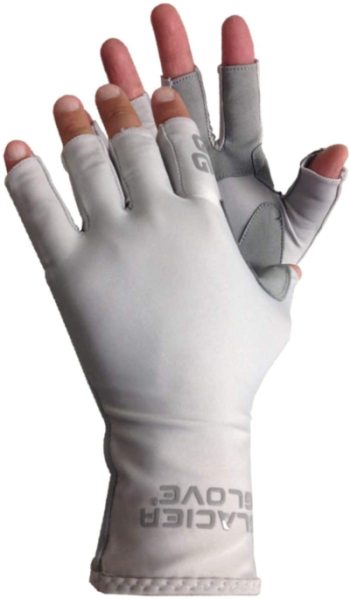
Material: Lycra and synthetic leather
Style: Fingerless
UPF rating: UPF50+
If you’re looking for a pair of gloves that blends warmth and protection with comfort, give these a try. They’re made with 85% Lycra, meaning they’re incredibly lightweight, breathable, and elastic, but the addition of 15% synthetic leather adds extra reinforcement, grip, and padding on the palms.
The fabric is quick-drying to keep your hands cool, and they do offer reliable sun protection. They’re thick enough that they feel durable but won’t compromise your grip on your paddle or get in the way of delicate finger movements. Their fit is true-to-size and the elastic cuff makes them beautifully easy to slip on and off.
On the downside, they will start to smell pretty quickly, and not even a thorough wash in the washing machine will fully eliminate bad odors. The finger holes are also extra-tight, making these gloves less than ideal for guys with thick fingers.
Pros:
- Elastic cuff has no need of closure, fits snugly
- Warm fabric (may actually feel hot!) to keep out the chill
- Comfortable and sized accurately
- Well-priced
Cons:
- Prone to bad odors
- Tight fit for people with thick fingers
NeoSport 3/4 Finger Neoprene Gloves, 1.5 mm
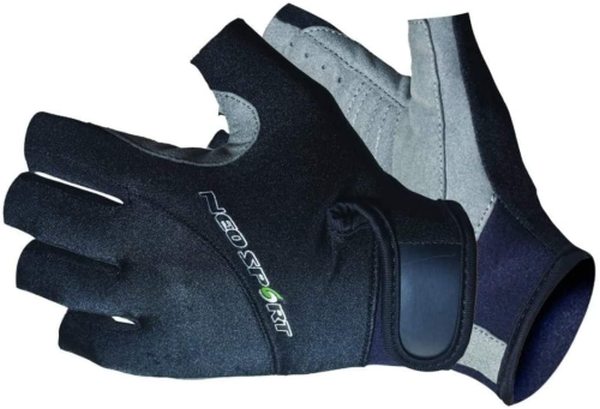
Material: Neoprene and synthetic leather
Style: Fingerless
UPF rating: Unspecified
Looking for a hard-wearing, sport-friendly pair of kayaking gloves to take on your next ocean or river adventure? Give these bad boys a try, and you won’t be sorry. They’re made using super-tough 1.5mm-thick neoprene with synthetic leather on the palm for added durability and comfort. They are actually designed for both wet and dry adventures, so you can take them diving, swimming, kayaking, hiking, climbing, biking, or even wakeboarding.
The gloves just feel right on your hands, with good cushioning on the palms to reduce calluses. Whether you’re holding a tow handle or paddle, the gloves’ inner surface will actually improve traction and give you better grip.
However, be warned: the sizing is extra-small, so you’ll need to order at least one size up for a proper fit. And, sadly, the neoprene won’t dry as quickly as Spandex or Lycra.
Pros:
- Durable and hard-wearing
- Compatible with wet and dry sport activities
- Good cushioning and grip
- Thick fabric provides added warmth
Cons:
- Slow to dry
- Sizes run very small
NRS Hydroskin Gloves
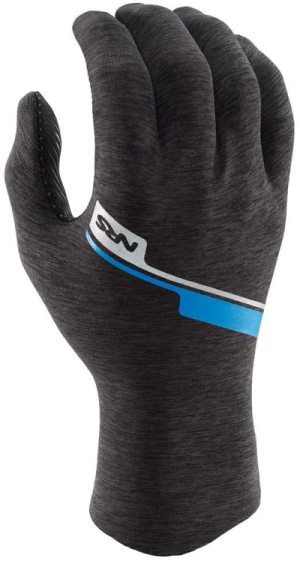
Material: PowerSpan synthetic fabric
Style: Full finger
UPF rating: Not rated
When the weather turns chilly or the water feels icy, you’ll want to have these gloves close at hand. Their full-finger design will keep the water out and the warmth in, so you can stay toasty even in cold-weather conditions.
They’re surprisingly thin for a full-finger glove, and they offer excellent grip (thanks to the DWR-coating and ThermalPlush palm) while also protecting you from calluses and blisters. The four-way stretch fabric is beautifully versatile for any water sport.
They are a bit pricier than some of the others on this list, and it will take some stretching to conform their shape to curl around your paddle. The fingers are also very narrow—too narrow for thick-fingered guys—but they’re slim enough to be a great pair of water gloves to wear as a base layer (if you’re kayaking in truly frigid winters).
Pros:
- Lightweight and thin, but good for added warmth
- Durable, elastic, and comfortable
- Synthetic fabric offers good waterproofing and grip
Cons:
- On the pricier side
- Narrow fingers
Hyperflex 3/4 Fingerless Gloves
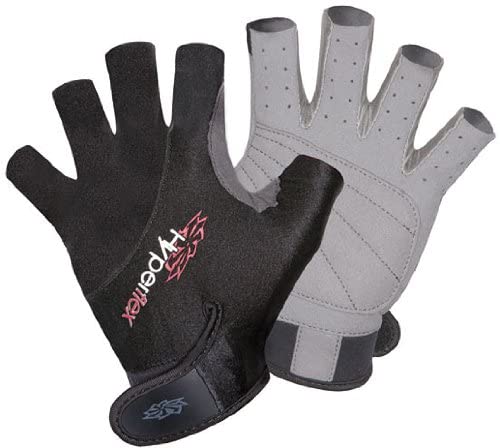
Material: Spandex and synthetic leather
Style: Fingerless
UPF rating: Unspecified
Whether you’re sailing, fishing, kayaking, or wakeboarding, you’ll find these gloves are more than tough enough to keep up with any sport. Thanks to their hook and loop Velcro closure, they’ll stay securely in place no matter how fast you’re going or how choppy the water gets.
The palms are covered with synthetic leather that increases grip and protects against blisters, but the backs of the gloves are made with a breathable Spandex that allow for better ventilation and moisture-wicking. Thanks to their ¾ length, you’ve still got free use of your fingertips while the rest of your hands is fully protected.
Fair warning: sizes run on the small side, and you may struggle to pull them on/take them off unless you order a size or two up. Windsurfers and wakeboarders may find the length is a bit uncomfortable, but they’re perfect for anglers and kayakers.
Pros:
- Solidly built, hyper-comfortable gloves
- Breathable while still being sturdy and well-padded
- Decent price tag
- Great for most watersports
Cons:
- Sizes run very small
- Finger length may be uncomfortable for anyone gripping a handle or rope
BASSDASH Astro Heavy-Duty Gloves
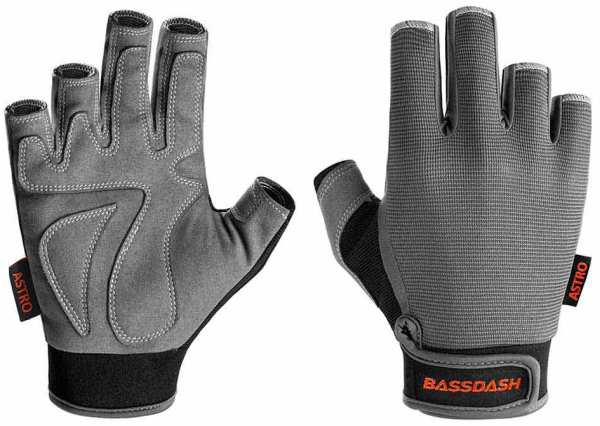
Material: Neoprene, Spandex, and synthetic leather
Style: Fingerless
UPF rating: Unspecified
You won’t find another pair of fishing or kayaking gloves quite like these! They’re designed with differing finger lengths—the index and middle fingers are ¾ length, while the ring and pinky fingers are ½ length—which offers you better grip and control over your paddle or fishing pole. You will be blown away by how this unique design makes them feel so much more dexterous, perfect for tying a fishing line or securing a rope.
The gloves definitely live up to their “heavy duty” claim. The combination of synthetic leather on the palms and four-way stretch Spandex and neoprene make for a truly hard-wearing glove. Users low how sturdy the microfiber leather on the palms feel, and how it provides both blister protection and better grip.
They’re not without their flaws, though: the padding between the thumb and forefinger could be thicker and/or placed better, and they’re not ideal for multi-day paddling trips.
Pros:
- Lightweight but sturdy and solidly stitched
- Comfortable, snug fit
- Good padding on the palms
- Unique finger design offers excellent dexterity
Cons:
- Padding is thin/incorrectly placed over the skin between thumb and forefinger, leading to blisters
BPS Water Gloves
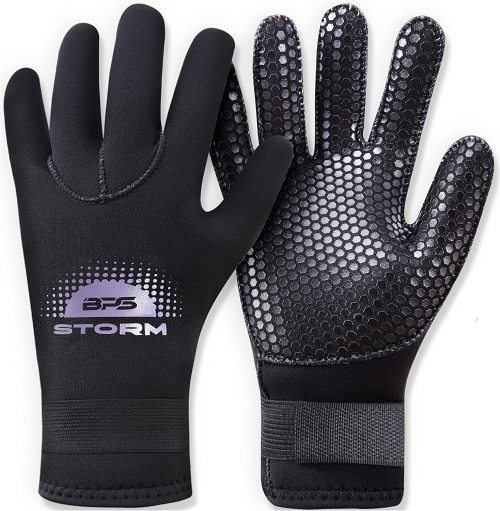
Material: Neoprene
Style: Full finger
UPF rating: Unrated
These may be diving gloves designed to use with a wetsuit, but they’ll do an amazing job of protecting your hands while kayaking, too. The neoprene is fully waterproof and surprisingly good at trapping in body heat, so your hands will never feel chilly no matter how cold the air and water is. Thanks to the textured palms, you’ll have excellent grip on your paddle even when the gloves are wet.
The double-lined neoprene is very durable, with reinforced and glued stitching that can withstand a lot of friction from your paddle. The adjustable wrist strap will make it easy to set the gloves to the perfect fit according to your hand size. Factor in the affordable price tag and the 12-month warranty, and you can see they’re a very solid choice.
Sizes do run small, though, and even if you order the “right” size, you will struggle to pull off the very tight-fitting gloves.
Pros:
- Great for use with a wet suit or dry suit
- Sturdy and wonderfully warm
- Comfortable, well-padded
- Reinforced seams will hold up for years of use
Cons:
- Sizes run small, and the fit can be very tight
Seavenger Abyss 1.5mm Neoprene Diving Gloves
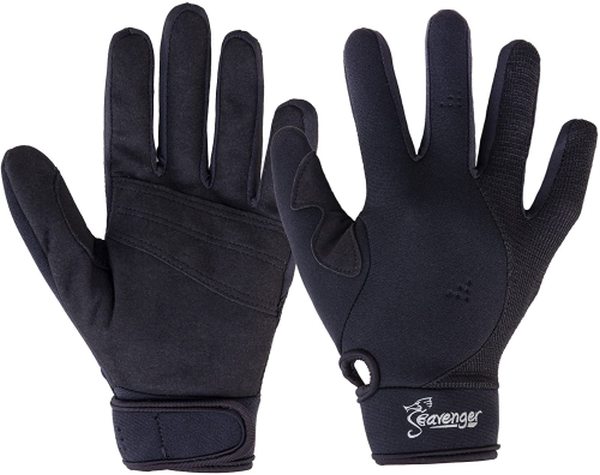
Material: Neoprene and synthetic leather
Style: Full-finger
UPF rating: Unrated
If you’re thinking of doing cold-weather kayaking, you may want to consider these diving gloves. Made from 1.5mm neoprene, they’re thick enough that they’ll keep out the chill while still offering excellent dexterity and freedom of movement. The synthetic leather used to reinforce and pad the palms, fingers, and thumbs will protect against blisters even on multi-day paddling trips.
There is just a hint of mesh on the gloves’ backing, so your hands will stay cool and dry inside the gloves. Thanks to the adjustable wristband, you can pull it as tight around your wrist as feels comfortable.
Users have complained that the synthetic leather (and seams) will “pill” like yarn/cotton with repeated friction. Also, sizes fit very snug—more so than is normal for neoprene diving gloves—so you’ll likely want to order a size up.
Pros:
- Great for cold-weather and cold water
- Thin neoprene offers excellent warmth without compromising dexterity or grip
- Synthetic leather reinforces and improves grip
- Will prevent blisters
Cons:
- Fabric prone to “fuzzing” or “pulling”
- Sizes run very small
Neo Sport Premium Neoprene Wetsuit Gloves
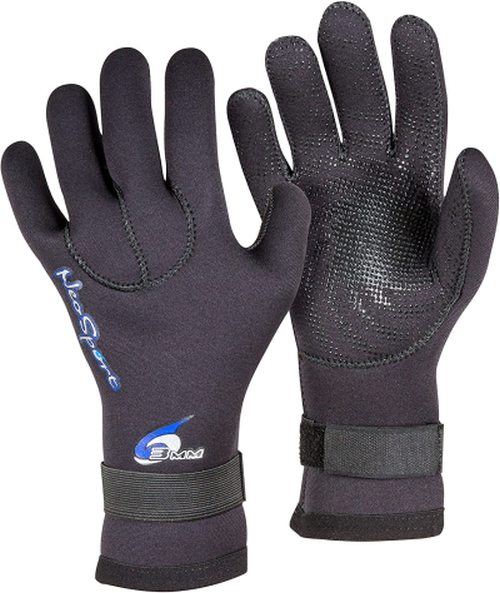
Material: Neoprene
Style: Full finger
UPF rating: Unrated
If you want a solid pair of heavy-duty, all-purpose gloves, you’ll love these bad boys. According to the product page, they’re compatible not just with kayaking and diving, but also “gutter cleaning” and “pond and aquarium maintenance”. Now that’s a claim that speaks to the durability and quality of the gloves for sure!
The gloves come in both 3mm and 5mm thicknesses, so you can choose according to whether your priority is versatility (thinner) or added warmth in freezing water (thicker). They’re compatible with any wetsuit or dry suit, with a snug fit and flexible fabric that makes them incredibly useful in just about any situation. Thanks to the Gator elastic closure and the hook-and-loop Velcro cuff, you are guaranteed to keep the water out and the warmth in.
Be warned: they are a bit bulkier than most of the other gloves on our list, and users have complained that they’re prone to breaking when using tools (underwater digging, spear-fishing, etc.).
Pros:
- Very thick and warm
- Durable gloves, great for cold and freezing-water use
- Affordable
- Comfortable and reliable, improves grip
Cons:
- Prone to defects (ripped stitching or holes)
- Size may be too snug
Glacier Glove Perfect Curve Waterproof Fleece-Lined Neoprene Gloves
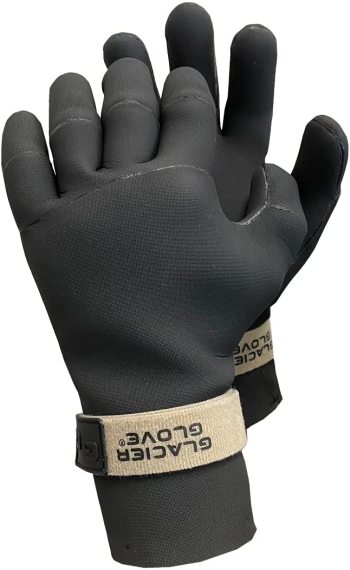
Material: Neoprene exterior with fleece lining
Style: Full finger
UPF rating: Unspecified
If you’re heading out into arctic conditions, these are absolutely the gloves you want with you. Not only are they made with a 2mm-thick neoprene exterior, but the interior is lining with super-warm polyester fleece. You’ll never have to worry about the chilly wind or freezing water seeping into these gloves—you’ll stay warm all winter long!
The fingers are actually pre-curved to wrap comfortably around your paddle, and they feature a pro strap that allows you to securely fasten them and guarantee waterproofing. The blind stitching and reinforced glue will prevent them from wearing out or breaking with repeated use.
Some users have complained that their gloves arrived defective and tended to leak, while others complained that the seam right on the skin between thumb and forefinger made paddling uncomfortable.
Pros:
- Sturdy and fully waterproof
- Comfortable, fleece lining is very warm
- Well-designed gloves perfect for kayakers
- Great for sailing, wakeboarding, and surfing
Cons:
- Stitch between the thumb and forefinger can be very uncomfortable
- Prone to manufacturer’s defects that compromise waterproofing and insulation
HEYTUR Neoprene Pogies
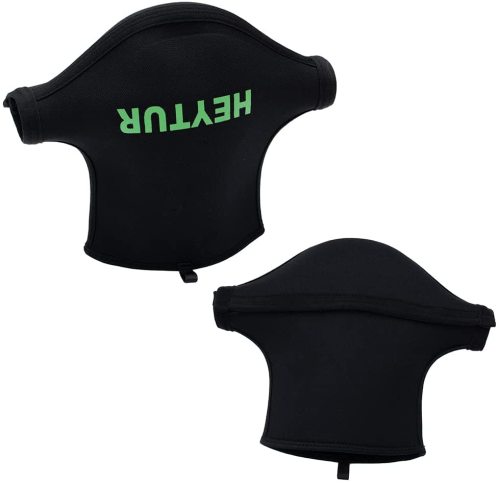
Material: Neoprene
Style: Pogie
UPF rating: Unrated
Made from super-thick 4mm neoprene, these pogies are the perfect solution to keep your hands warm and dry while also allowing you to move your hands freely when not paddling. Simply slip them onto the paddle’s handle, close the Velcro strap to secure them in place, and you’re ready to head out on the water.
The pull tab on the cuff makes it easy to slide these pogies on and off, and they’re designed to be “one size fits all”, so no need to worry about incorrect sizing. Thanks to the flat-stitching seams and anti-flush cuff, they’re a durable choice that will be perfect for winter or whitewater kayaking.
Pros:
- Warm enough you won’t need to wear gloves, too
- Stay securely in place
- Fuzzy lining on the interior is super soft and warm
- Easy to slide on and off
Cons:
- No protection once you remove your hands from the paddle
- Not very versatile, can’t perform any other non-paddling tasks
Complete Buyer’s Guide: What to Consider When Choosing Kayaking Gloves
Types of Paddling Gloves
Kayaking gloves come in four basic styles:
Fingerless Gloves
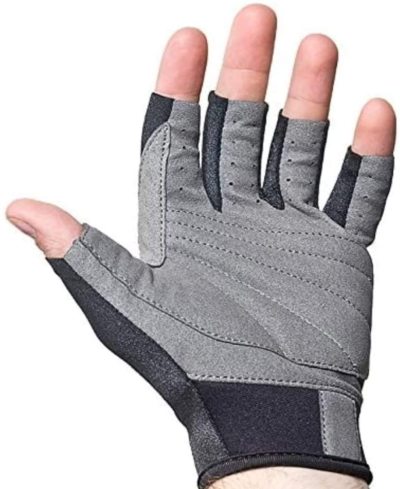
Fingerless gloves are ideal for warm-weather kayaking when you want to protect your hands but still prioritize finger dexterity (for tying knots, threading a fishing line, squeezing a rifle trigger, using your smartphone touchscreen, etc.). However, because they don’t cover your fingers completely, there is still a risk of sunburn and/or chill from very cold water.
Full-Finger Gloves
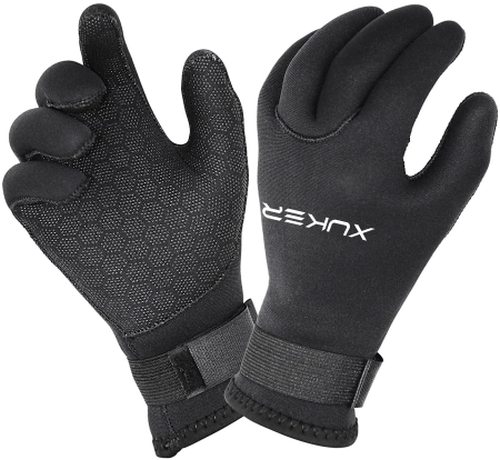
Gloves with fingers are better suited to kayaking in colder lakes/rivers/oceans or all-day kayaking trips, because they provide full protection from the cold water as well as the sun. However, the fingers will interfere slightly with your manual dexterity, and may make complex, delicate tasks (like tying a knot) more challenging.
Kayaking Mitts
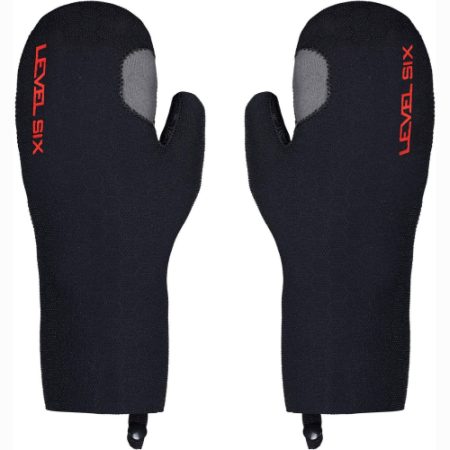
Kayaking mitts are best for very cold conditions. They’re typically designed to be fully waterproof and are made with some sort of thermal or thermal-lined fabric that keeps out the cold and traps heat close to your hands. If you’re kayaking during the colder months of the year and want to prioritize warmth over dexterity, mitts are a good choice.
Pogies
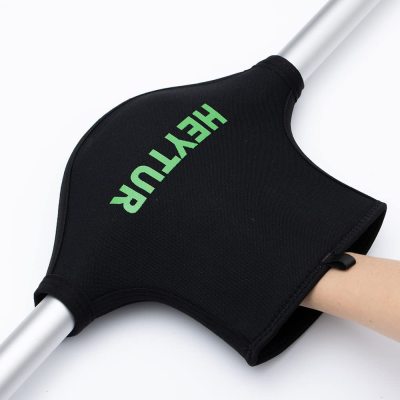
Pogies are an interesting twist on mitts. Instead of pulling them onto your hands, you actually slide them onto the shaft of your paddle, then insert your hands into the pogies to keep them warm. Think of them like paddle-mounted hand warmers great for cold weather kayaking—they’re typically very thick and designed to provide insulation for your hands, but they remain secured to the paddle rather than worn on the hands.
The majority of kayakers will use gloves (either fingerless or with fingers), but both pogies and mitts are a good option for truly cold-weather paddling. It’s all about what the weather and water are like, and how you want to best protect your hands from the chill, sunburn, and the friction of gripping/handling a paddle.
Choosing Kayak Gloves That Fit
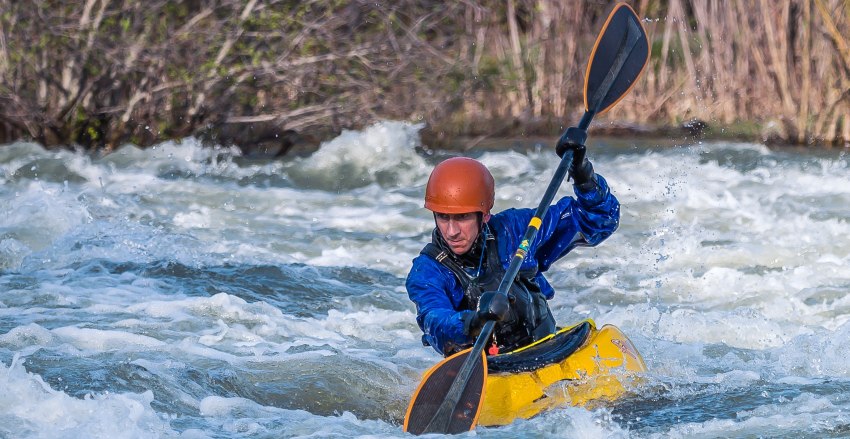
The expression “fits like a glove” exists for a reason. Gloves need to fit just right, otherwise, they can be uncomfortable—possibly even dangerous.
How can gloves be dangerous? Let me explain…
A glove that is too tight will restrict circulation to your hands. Reduced blood flow means less body heat is generated, which makes your fingers even more prone to chill—or, in wintry conditions, frostbite.
A glove that is too loose will rub against your hands, causing blisters from all the extra friction. The excess fabric is also more likely to get caught—say on a fishing line or even on the blades of your trolling motor.
That’s why it’s imperative that you find kayaking gloves that fit just right.
When shopping for glove sizes, you need to consider both the palm size and the width/length of the fingers.
This has historically been a problem for me, because I have bigger-than-average palms but shorter-than-average fingers. For me, fingerless gloves have been the best choice because I can find the right fit for my palms without having to worry about incorrect sizing on the fingers.
Make sure to test the gloves at your wrists, palms, fingers, and knuckles to make sure you find the right fit!
Palm Grip/Padding
Some gloves include a specialized textured surface on the palm that will help to increase the grip on your paddle. Typically, it’ll be rubber, neoprene, or some other material that retains its friction even when wet.
However, you may also want to find a pair of gloves that includes a bit of palm padding as well. A layer of padding will help to prevent calluses, particularly on the sensitive skin between your thumb and forefinger.
Note: It may be tempting to use old motorcycle or cycling gloves for kayaking because of the textured/padded palms, but remember that leather does not hold up well when exposed to water.
Glove Material
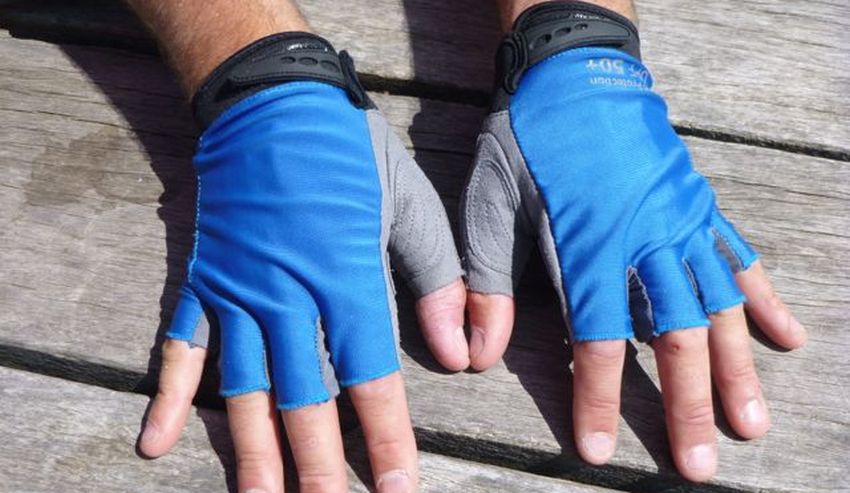
Kayaking gloves are typically made from a combination of synthetic fabrics, such as polyester, nylon, neoprene, lycra, spandex, and artificial suede or leather.
All of these fabrics dry quickly, pull moisture away from your skin, and have enough elasticity that they flex and move with your hands.
For warm weather, you’re typically looking at a pair of polyester or nylon gloves made with either Lycra or Spandex. These fabrics shield you from the sun and are abrasion-resistant to protect your hands from the friction of gripping your paddle.
For cold weather, however, neoprene is the fabric of choice. Spandex and Lycra aren’t waterproof, so they won’t protect your hands from getting wet. Neoprene, on the other hand, is the fabric used to make wetsuits, a synthetic form of rubber that is fully waterproof. It’s got a spongy texture that offers padding to protect your hands from friction and is thick and insulating enough to trap body heat to keep your hands warm.
RELATED: Best Kayaking Wetsuits for 2023
Some gloves will also use a synthetic leather to add an extra layer of padding/grip on the palms, or to protect the gloves against friction damage.
How Thick Should Your Paddling Gloves Be?
The thickness or thinness of your kayaking gloves will be determined by two main factors:
1. The weather/temperature. Neoprene is a thicker material (usually around 3-5 mm) that provides excellent insulation against the cold and padding for your hands. Spandex and Lycra, on the other hand, are usually thinner (1-2 mm) and will offer less warmth while still maintaining good protection against friction. Thinner gloves are best-suited for warm-weather kayaking, while thicker gloves are better for cold-weather kayaking.
2. Your main needs. If you’re looking to improve your grip on your paddle (such as for high-intensity whitewater kayaking), you’ll want a thinner glove that puts only a very thin layer of grippy fabric between your hands and the shaft of your paddle. If you’re looking for better warmth and/or cushioning against friction, you may want to consider a thicker glove.
Durability
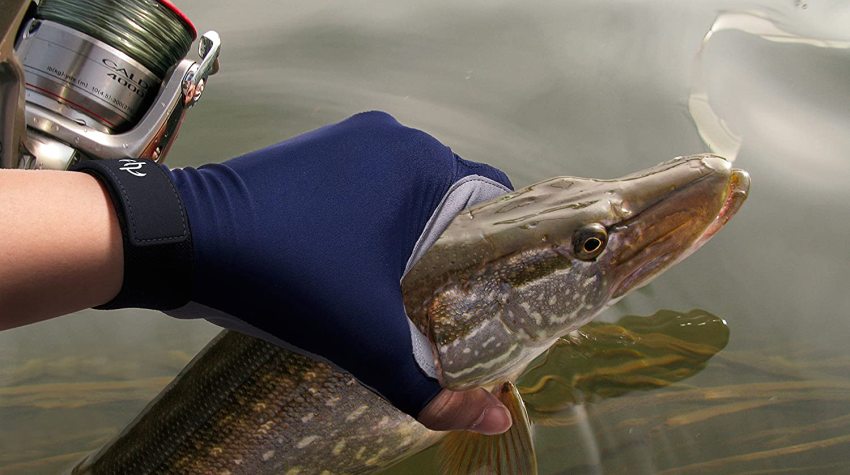
Durability is always a factor to consider when shopping for kayaking gear—any gear that will be exposed to water, really.
Water will accelerate the deterioration of most fabrics and materials, and may even weaken the threads that are used to stitch together the various parts of your gloves. The thinner the fabric, the faster it will wear out as a result of friction, sun exposure, and constantly getting wet/drying out.
There are ways to increase durability:
- Using higher quality fabrics. Spandex, Lycra, and Neoprene are all solid choices, but Neoprene tends to be both thicker and marginally more durable than the other two.
- Adding layers of protection, such as a synthetic rubber or leather textured surface on the palms, fingers, and other parts where lots of friction will be generated.
- Reinforcing the seams using specialized stitching, extra-durable thread, or even glues.
Look for the kayaking gloves that emphasize durability, even if that means paying a little more!
Breathability
Most people only realize how important of a factor breathability is after a few day-long or multi-day paddling trips wearing the wrong gloves.
Gloves will keep your hands warm, but they may be thick/insulated enough that your hands can start to overheat or sweat excessively. When this happens, the moisture gets absorbed into the gloves’ inner lining, increasing friction against your skin and raising the risk of blisters.
ALSO SEE: Best Kayaking Pants
A good pair of kayaking gloves will feature some form of breathable mesh—either on the backs of the gloves, or as a lining inside the thicker neoprene shell—to pull moisture away from the hands and keep your hands cool/dry while you paddle. It’s an added feature that will do wonders to prevent blisters!
UPF Rating
Most of us want to spend all our time paddling when the sun is high and the day is warm, but that’s also when there is the highest risk of UV radiation exposure from the sunlight.
The EPA warns that UVB radiation can lead to skin cancer, so it’s important that you’re protected. Typically, that means wearing sunscreen or clothing that includes some form of UV protection—or, as it’s more commonly known, Ultraviolet Protection Factor (UPF).
Synthetic fabrics on their own may only be mildly effective at shielding your hands from sunburn and excessive exposure to solar radiation. Look for gloves that include a UPF factor between 30 and 50 to ensure your hands are protected!
Closure
How the gloves close will determine just how easy/difficult they are to remove in a hurry.
Velcro is the classic closure, both because of how secure it is when engaged and how easy it is to disengage. Velcro cuffs also allow you to customize the fit of the glove.
Elastic cuffs are typically featured on the cheap gloves, and won’t offer the most secure fit. However, they make it easy to slip the glove off and on in a hurry.
Zippers offer the most secure fit, but be warned: the metal hardware is prone to rusting after repeated exposure to/contact with water.
Smartphone Compatibility
Let’s be real: you’re probably not going to spend too much time on your smartphone while out paddling.
I know that as long as I’m away from dry land, my phone stays securely tucked away in my dry bag—the last thing I want is to lose my phone by dropping it overboard or letting it be damaged by water.
But if you’re spending a full day fishing or hunting, you need to access maps/GPS to track your position, or you’re navigating a tricky system of rivers and portages, you may want to pull out your phone every now and then.
Fingerless gloves make using your phone easy, but some gloves with fingers will include a special patch of fabric on the thumb and/or forefinger that is smartphone-compatible. It’s not a must-have for kayakers, but is a very convenient addition.
How to Properly Care for Kayak Gloves
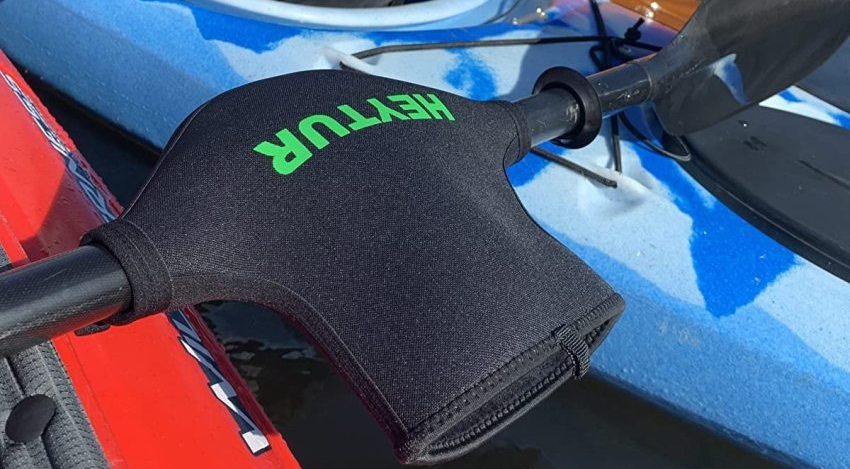
Even the best kayaking gloves will wear out over time. That’s just the way it works with gear that is exposed to sunlight, friction, water, and the elements.
But there are a few things you can do to extend the lifespan of your gloves, and it all starts with taking good care of them.
Check the seams after each use
Give the gloves a once-over, and look for any seams that are fraying or stretching. If you notice any damage, consider making repairs. For neoprene gloves, you can use the GEAR AID Wetsuit Repair Kit with Neoprene Patch or Aquaseal NEO Contact Cement. Spandex and Lycra are a bit harder to repair, but the good folks over at Sewing is Cool have a great primer on how to fix stretch fabrics.
Rinse well after use, especially in saltwater
Saltwater will deteriorate most synthetic fabrics at an accelerated rate, and rivers and lakes are filled with bacteria and fungi that could eat through the gloves. It’s absolutely vital that you rinse your gloves thoroughly in freshwater (in your tub or sink) after every use.
Wash using wetsuit detergent (or baby soap)
Revivex, for example, is a specialized wetsuit & drysuit shampoo formulated specifically for neoprene. Do this once every few weeks to ensure the gloves are thoroughly cleaned.
Stuff with newspaper and hang to dry
Don’t run the gloves through your dryer, but hang them up to dry someplace indoors that is both warm and well-ventilated. Drying them in the sun will break down the synthetic fabric, shortening the gloves’ lifespan significantly. Stuffing the gloves with newspaper will expand them and help them to dry faster and more evenly.
Dry thoroughly before storing
Never put your gloves away wet—doing so will lead to the formation of mold and bacteria. Make sure the gloves are fully dry before putting them away.
Store in a dark, dry place
Direct sunlight and excessive moisture will cause the synthetic fabrics to deteriorate faster. Always keep the gloves someplace dark and dry when not in use!
Kayak Gloves FAQs
Gloves are the best solution for kayakers to prevent blisters, but you can also use anti-blister pads, anti-blister tape, or even a special anti-blister silicone paddle grip to protect your hands. All of them will be highly effective at reducing friction, so use one or more of these solutions if you find your skin is prone to irritation or blistering.
Most kayak gloves are sized around the palm, with a sort of “average” for finger length/width. To figure out your size, wrap a tape measure around your palm at the widest part (not including your thumb). You’ll typically get a size between 5 and 9 (though people with extra-large or extra-small hands may find their results differ), and that number will tell you what glove size to buy.
Wetsuit gloves should feel very snug when you first put them on—snug enough that they won’t slip or slide, but not so tight that they cut off circulation. If the glove feels like a standard glove, it may be too large, because neoprene expands slightly when it gets wet.
Biking/cycling gloves are typically made using lightweight, abrasion-resistant, grippy materials that will help to reduce friction and protect your hands. However, the fabric isn’t typically water-resistant or waterproof, and will likely be damaged when they get wet. They’re a good backup option in a pinch, but you’re better off just buying kayak gloves and keeping your biking gloves for use on dry land.


